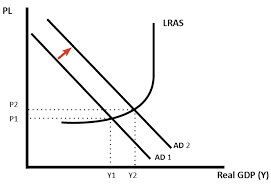Evaluate the likely impact of an increase in protectionism on the global economy (25 Marks)
Protectionism means adding barriers to free trade, such as tariffs, quotas and embargoes. To judge if protectionism has a positive or negative impact, we should consider the impact of tariffs on the four main macroeconomic objectives. These are price stability, economic growth, employment rates and balance of payments.
A tariff is a tax on imports. The diagram below shows that a tariff causes the world supply curve to decrease (shift up). The world supply curve is perfectly elastic because there are almost infinite buyers and sellers in the entire global economy compared to the UK economy. This shifts up because a tariff is an extra cost of production for foreign firms. If this curve shifts up, the quantity of goods bought in the UK increases from q to q1 and the quantity of imports decreases from qq3 to q1q2.
So, one advantage of implementing a tariff is that it benefits UK firms by making foreign firms less competitive. The World Price goes up from P1 to P2. This allows UK firms to sell more. from Q to Q1. They also are able to sell at a higher price now. Also, the quantity of imports decreases at the same time. Because aggregate demand is AD = C +I + G + (X-M), if X goes up and M goes down. the UK aggregate demand curve shifts to the right.

If AD shifts to the right means that real GDP increases from y1 to y2. This means that we see more economic growth (which is an increase in the rate of growth of real GDP), and we also see an increase in employment. If there is more employment, there will be more people with more disposable incomes and this would lead to an increase in economic welfare in the UK. One other advantage is that the government gain tax revenue of q1q2p1p2. This could be useful to improve public services or to implement other policies such as supply-side policies which can lead to improvements in LRAS, meaning that the quality and capacity of the UK economy increase and that UK exports become more competitive in the long run naturally.
However, this would not be the case if the UK were not producing goods at a similar low cost and quality as the foreign firms. If this was the case, people would still import goods despite the higher price, so this intervention would have unintended consequences, and could be seen as a government failure. It is important to back up protectionism with solid supply-side policies.
On the other hand, protectionism can be costly as it can lead to trade wars and take away the benefits of free trade. Free trade is the act of trading without any protectionism. The main argument in favour of free trade is that free trade allows each country to make use of their comparative advantage; this is when a country produces a good at a lower opportunity cost. This allows total world output to increase.

This diagram illustrates that, although country B has an absolute advantage in cars and trucks, we can see it is only marginally better at making cars than country A, but significantly better at making trucks. If each country specialised according to its comparative advantage, total output would increase, and in the long run, this benefits all countries.
The other disadvantage of protectionism was that it could lead to trade wars. If we try to make domestic goods more competitive to improve our balance of payments, then other countries could retaliate and put their own tariffs or quotas on UK exports. This would cause our exports to decrease and would cause AD to shift to the left. If all countries implemented protectionism, countries would not be able to specialise easily because specialisation requires free trade, and this would lead to the domestic economy being damaged as well as the total world output. This could be especially damaging on goods that the UK are dependent on, where demand is quite inelastic. If this is the case, and if UK firms are not competing on quality, it leads to a welfare loss (shown by the pink triangles in the tariff diagram).
However, if we are not competitive, protectionism would force us to be over time. Anything that is too expensive to import, UK producers would have stronger incentives to improve on. These incentives are not as strong when it is the easy option to import such things. Also, the tax revenue from tariffs can help subsidise firms producing these goods and services.
Overall. I believe that there is more of a negative impact of protectionism on the global economy, mainly because of the comparative advantage theory and the risk of trade wars in a global economy with growing inter-dependence.
PLAN:
Intro: definitions and explain that protectionism has advantages and disadvantages and we can judge the impact of these by considering the 4 macroeconomic objectives
Why protectionism is good for UK e.g. AD shifts to the right
Why protectionism is bad for UK: trade wars, we used to benefit from cheap imports before (quality, cost), free trade (COMPARATIVE ADVANTAGE)
Conclude by stating what it depends on and why overall protectionism is good/ bad